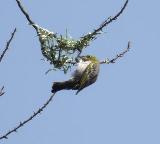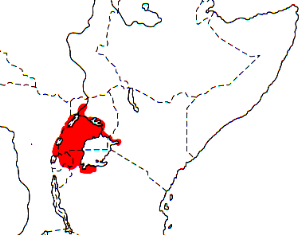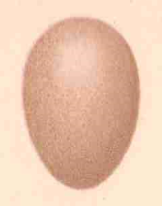Weaver species
Choose different species from drop-down list and press 'Go' button. See Full species list.Northern Brown-throated Weaver Ploceus castanops
IUCN: Least concern Discovery: 086Categories: wetland,
News items about species
Discovery
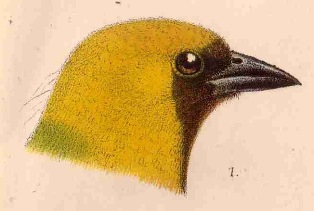
figure from Sharpe (1890) 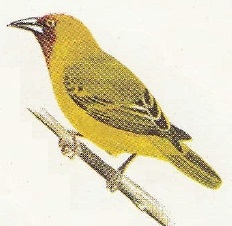
figure from Mackworth (1955) 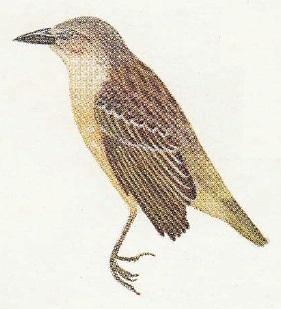
figure from Mackworth (1955) 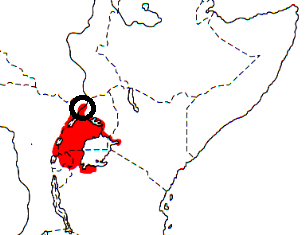
distribution, type locality circled IntroductionThe Northern Brown-throated Weaver was formally described by George Ernest Shelley, an English geologist and ornithologist.The Northern Brown-throated Weaver was collected by Emin Pasha, an Ottoman-German physician, naturalist, and governor. After 1876, Emin made Lado (South Sudan) in Equatoria province his base for collecting expeditions throughout the region, and here he collected type of the Cardinal Quelea. In 1881 there was a revolt by Muhammad Ahmad, and the revolt cut Equatoria off from the outside world by 1883. In 1884 Karam Allah marched south to capture Equatoria and Emin. In 1885, Emin and most of his forces withdrew further south, to Wadelai near Lake Albert, in Uganda. In August Pasha collected some male and female specimens of the Northern Brown-throated Weaver around Wadelai, and not in Lado as noted by some authors. There was a danger of the specimens being lost due to the revolt, but Rev. Mackay eventually took them to the Kenyan coast, and were sent to the British Museum. The first illustration of the Northern Brown-throated Weaver was of the head of the male published by Sharpe (1890). The next illustration to be published was of an egg by Ogilvie-Grant (1912), followed much later by colour paintings of the male and female in Mackworth (1955). Scientific citationPloceus castanops Shelley 1888, Proc. Zool. Soc. London, p.35 Lado (Wadelai, Uganda).Meaning of namescastanops, Latin: castaneus, chestnut-coloured; Gr. Ops, the face.First English nameNile Brown-throated Weaver (Shelley 1905).Alternate namesBrown-faced Golden Weaver, Nile Brown-throated Weaver.CollectorEmin Pasha.Date collected12 August 1885.Locality collectedWadelai, Uganda.Type specimensThere are at least 4 syntypes in the British Museum, including BM 1887.9.28.62. |
The above is based on Weaver Wednesday 2, a weekly series about the discovery of each weaver species.
This species text first appeared as
Weaver Wednesday [203] - Discovery [86]: Northern Brown-throated Weaver on 2016-05-04
1. Basic biology
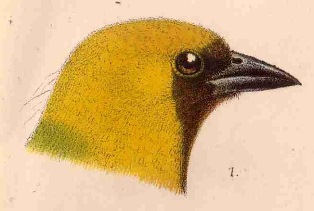
figure from Sharpe 1890 The female has a streaked back and tawny-buff breast and is distinguished by black lores and a pale eye, a buff (not yellow) supercilium, lack of yellow on the underparts, and a more slender bill. The female Orange Weaver has a pale bill and whitish underparts. The range of the Northern Brown-throated Weaver does not overlap with the similar Southern Brown-throated Weaver. Distribution.
The Northern Brown-throated Weaver is locally common in Uganda and surrounding countries in the Lake Victoria basin (see map below, based on Birds of Africa). No subspecies are recognised.
Habitat. The Northern Brown-throated Weaver inhabits waterside vegetation along lakes and rivers, especially in papyrus and ambatch. It visits forest and woodland habitats in the non-breeding season. Food. The Northern Brown-throated Weaver feeds on seeds, including millet, and also on insects. It forages in small flocks, often with other weavers, on the ground, in vegetation and on floating aquatic plants. The foot structure shows adaptations typical of papyrus specialists. Breeding. The Northern Brown-throated Weaver is apparently monogamous. It is colonial, with 5-6 nests in one site, but also nests solitarily. The nest is placed in tall elephant grass, low shrubs, in reeds, papyrus, bulrushes or ambatch. It sometimes breeds in mixed species colonies. The nest is rounded, tightly woven, and with the entrance below covered by a small projecting porch. The nest is built by the male from strips of grass and creepers, and lined with fine grass and some feathers. The clutch is 2-3 eggs, and egg colour is pinkish or pale blue, plain or spotted with red-brown. The chicks are fed by both male and female. Known nest predators include egg-eating snakes. Old nests may be used by Swamp Flycatchers Muscicapa aquatica.
|
The above is based on Weaver Wednesday, a weekly series about weaver species.
This species text first appeared as
Weaver Wednesday [74]: Northern Brown-throated Weaver on 2013-11-13
2. Breeding facts
| Pair bond Apparently monogamous Breeding season all months, with peak egg-laying Mar-May and Sept, in Uganda; in Feb-May and Jul in DRCongo Nest site placed in tall elephant grass or low shrub, or in swamps, in reeds, papyrus, bulrushes (Typha) or ambatch Nest building built by male Colony size Colonial, with 5-6 nests in one tree Clutch size 2-3 eggs Egg colour either pinkish or pale blue, immaculate or spotted with red-brown Egg size average size 22.5 x 14.5 mm (Uganda) Incubation no information Chicks and nestling period chicks fed by both male and female |
Breeding information based on Handbook of the Birds of the World, Vol. 15.
3. Photos of Weaver Nests
 Vm 30384 |  Vm 30071 |  Vm 30070 |  Vm 30069 |  Vm 30068 |  Vm 30067 |
Thumb-nails of most recent PHOWN records - click on one to see its full record
See all PHOWN records for this species here.
PHOWN (Photos of Weaver Nests) provides valuable info on breeding distribution and colony sizes of weavers.
You can contribute by registering and submitting photos at Virtual Museum webpage.
4. Breeding distribution
Google map showing distribution (For species with small ranges you need to zoom in at the correct area to see the range):
yellow blob - range of weaver species; read more about this here.
![]() - PHOWN records with photos
- PHOWN records with photos
![]() - PHOWN records with no photos (Nest Record Cards, other records)
- PHOWN records with no photos (Nest Record Cards, other records)
![]() - Birdpix records
- Birdpix records
![]() - comments on out of range records, or interesting records
- comments on out of range records, or interesting records
![]() - type locality
- type locality
CLICK on the marker on the map to see individual record details.
5. Range changes
Not South African speciesThe above is based on Weaver Wednesday 3, a weekly series about range changes in South African weaver species.
This species text first appeared as
n/a








